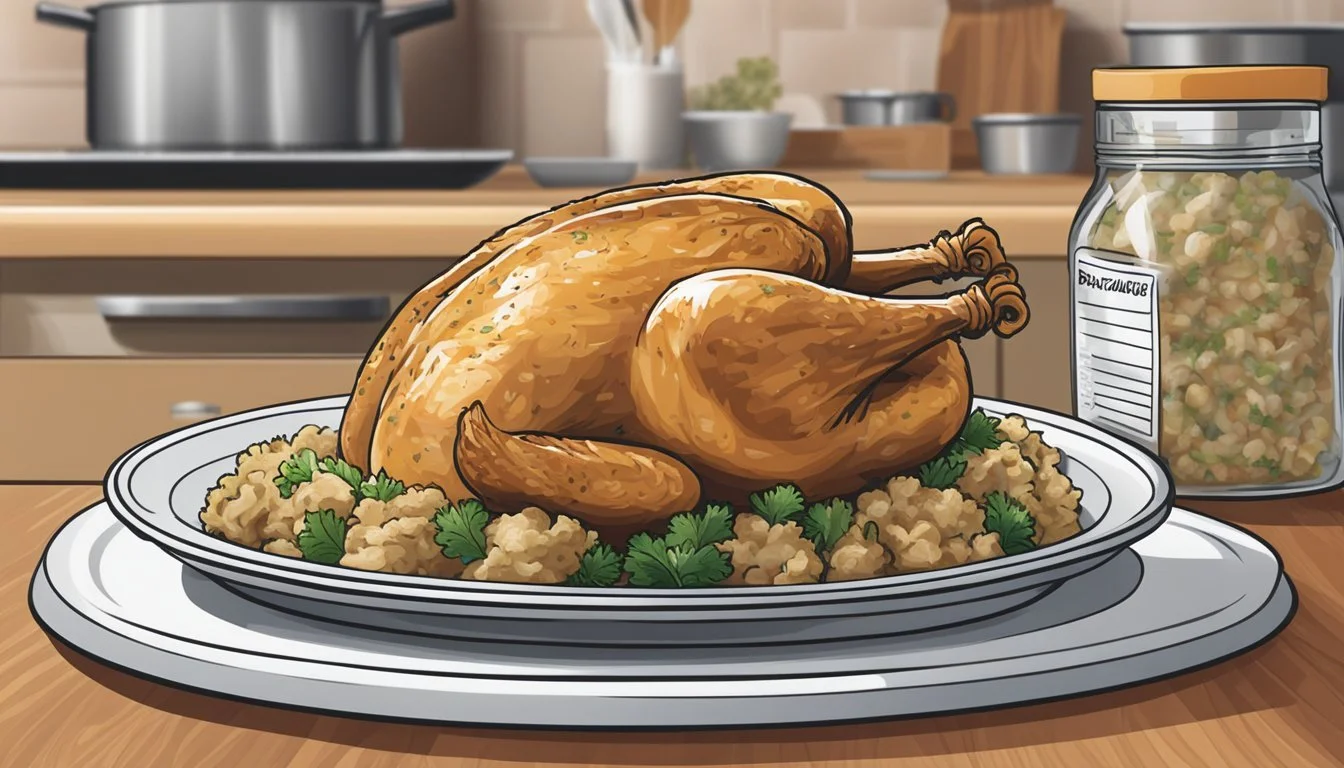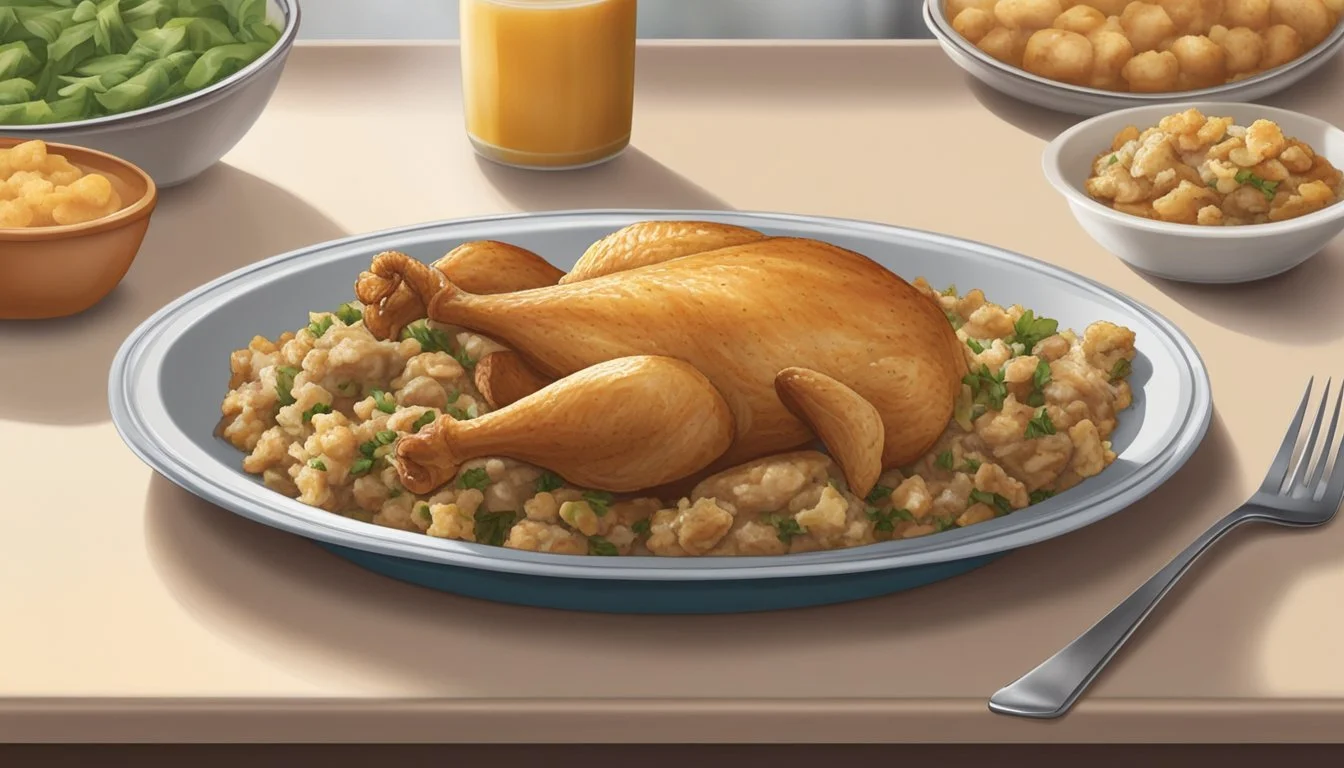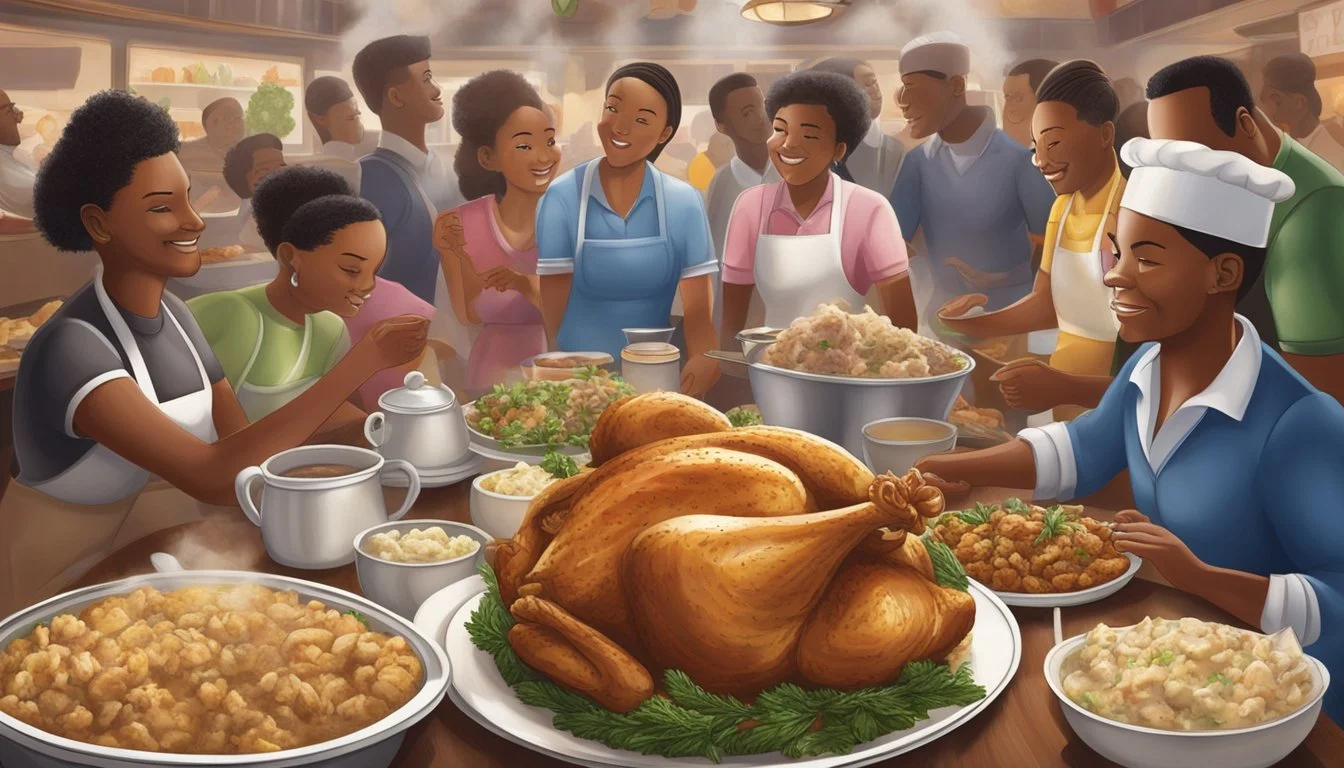How Long Does Boston Market Chicken & Stuffing Last?
Storage Tips and Shelf Life
Boston Market's chicken and stuffing are popular comfort foods, but how long can you safely store them? Freshly made Boston Market chicken and stuffing can last up to 3 to 4 days in the fridge if stored properly. For those who prefer to extend the shelf life, freezing is an option, with these meals lasting up to 2 to 6 months in the freezer.
Reheating is straightforward as well. When reheating stuffing in the oven, preheat it to 350°F and ensure it's covered to retain moisture. Chicken can be reheated in a similar fashion but should reach an internal temperature of 165°F to ensure safety. Effective storage and reheating methods ensure that your Boston Market favorites remain delicious and safe to eat.
Long-term storage can be practical, especially with bulk purchases or meal prepping. However, always be mindful of food safety guidelines to enjoy Boston Market dishes at their best quality.
Food Safety and Health Risks
When handling Boston Market chicken and stuffing, food safety is paramount. Improper storage or preparation can lead to bacterial growth, presenting various health risks.
Internal Temperature: Chicken should be cooked to an internal temperature of 165°F to ensure harmful bacteria like Salmonella and E. coli are killed.
Cross-Contamination: Avoid cross-contamination by keeping raw chicken and its juices away from ready-to-eat foods. This helps prevent the spread of bacteria.
Expiration Date: Always check the expiration date of both chicken and stuffing. Consuming these items past their expiration date increases the risk of foodborne illnesses.
Signs of Spoilage: Look for signs of spoilage such as an off smell, slimy texture, or discoloration in the meat. Stuffing that has gone bad may also have an unusual smell or appearance.
Storage: Proper storage is crucial for extending the shelf life. Store leftovers in airtight containers and refrigerate them promptly.
Health Risks: Consuming spoiled chicken and stuffing can lead to food poisoning, which may cause symptoms like nausea, vomiting, and diarrhea.
By following these guidelines, you can minimize the risk of health issues related to consuming Boston Market chicken and stuffing.
Understanding Shelf Life
Shelf life refers to the duration during which Boston Market chicken and stuffing maintain their peak quality and safety for consumption. Several factors influence the shelf life of this meal, including storage conditions, preparation methods, and ingredient quality.
When properly stored in the refrigerator, Boston Market chicken and stuffing can last up to 3-4 days. Each component of the meal, such as the chicken and stuffing, must be cooled to room temperature before refrigeration to avoid moisture buildup that can lead to spoilage.
Factors Affecting Shelf Life:
Temperature: Keeping the meal in a consistently cool environment is crucial. The ideal temperature for refrigeration is below 40°F (4°C).
Moisture Content: High moisture levels can promote bacterial growth. Ensuring that the stuffing, in particular, has a balanced moisture content is essential.
Appearance and Color: Fresh chicken and stuffing should not exhibit any unusual discoloration. Changes in color can indicate spoilage.
Odors: Any sour or strange smells are signs that the meal is past its safe consumption period.
Texture: The stuffing should retain its firm texture. A soggy or overly dry consistency can suggest loss of quality.
Visual Indicators of Spoilage:
Indicators What to Check For Color Discoloration or dark spots Texture Sogginess or extreme dryness Odors Sour or unpleasant smells Mold Any visible mold or unusual growths
By regularly checking these indicators and maintaining proper storage practices, the quality and safety of Boston Market chicken and stuffing can be preserved effectively.
Storage Solutions
Proper storage of Boston Market chicken and stuffing is essential to ensure safety and maintain flavor. Whether refrigerating or freezing, follow specific guidelines to keep your leftovers tasting as fresh as possible.
Refrigeration Best Practices
Boston Market chicken and stuffing should be stored in the refrigerator at temperatures below 40°F (4°C). Place them in airtight containers to prevent contaminants and maintain moisture. It’s critical to refrigerate leftovers within 2 hours of serving to minimize bacterial growth.
For best quality, consume refrigerated chicken and stuffing within 3 to 4 days. Always monitor for any off smells or texture changes before consumption. If food looks or smells unpleasant, it is safer to discard it. Proper storage in the refrigerator involves using airtight containers and keeping the refrigerator at the appropriate temperature.
Freezing Techniques
When freezing Boston Market chicken and stuffing, proper sealing is crucial. Use freezer bags or airtight containers to avoid freezer burn and preserve flavor. Label packages with dates to keep track of storage times.
Chicken and stuffing can typically be stored in the freezer for up to 2-3 months. For best results, make sure the food is cooled to room temperature before freezing to prevent ice crystals from forming. Defrost frozen items in the refrigerator to reduce the risk of bacterial contamination.
By following these storage guidelines, you can extend the shelf life of your Boston Market meals while ensuring they remain delicious and safe to eat.
Handling Leftovers
To maintain the freshness of Boston Market chicken and stuffing, handling leftovers properly is essential.
Leftovers should be cooled to room temperature within two hours of cooking.
After cooling, place them in refrigeration immediately to prevent bacterial growth. Use airtight containers to store them properly.
Chicken and stuffing can be stored in the fridge for 3 to 4 days. Ensure they are covered well to preserve their flavor and prevent contamination.
For an extended shelf life, freeze the leftovers. Both chicken and stuffing can last up to 4 months in the freezer.
Label containers with dates to keep track of freshness.
Reheating Leftover Stuffing
To reheat leftover stuffing, preheat the oven to 350°F (177°C).
Place the stuffing in an oven-safe dish, cover with foil, and bake for 20 to 30 minutes. For a crispier texture, remove the foil during the last few minutes of baking.
A microwave can also be used, but stovetop reheating provides better control.
Signs of Spoilage
Check for any unpleasant odors or changes in texture before consuming.
Discard leftovers if there are signs of spoilage, such as mucus-like consistency or sour smell.
Proper handling and storage are key to enjoying leftover Boston Market chicken and stuffing safely.
Food Preparation and Serving
Boston Market Chicken & Stuffing can be enjoyed by following accurate preparation methods. Cooking the chicken properly ensures a juicy, flavorful meal. It typically involves roasting the chicken in the oven at 375°F for about 1-1.5 hours until the internal temperature reaches 165°F.
For the stuffing, making homemade stuffing involves mixing bread crumbs, broth, and a variety of other ingredients. This can be prepared separately or cooked inside the chicken. Stovetop stuffing should be simmered on low heat until all the liquid is absorbed, which usually takes around 10-15 minutes.
When reheating the leftover chicken and stuffing, use an oven-safe dish. Preheat the oven to 350°F and cover the dish with foil to avoid drying out. Bake for 20-30 minutes, removing the foil in the last few minutes to crisp up the stuffing.
For quicker reheating, the microwave can be used. Place the chicken and stuffing in a microwave-safe container, cover it loosely, and heat on high for 2-3 minutes, checking periodically to ensure even heating.
Serving the chicken and stuffing involves ensuring it is thoroughly reheated to at least 165°F for safety. The chicken should be golden brown, and the stuffing should have a mix of soft and crispy textures for the best experience.
Careful preparation and proper serving methods are essential for maintaining the quality and safety of Boston Market Chicken & Stuffing, ensuring a delightful and satisfying meal.
Specifics for Stuffing
Knowing how long stuffing lasts and the best way to reheat it is essential for preserving quality and ensuring safety. Here are the details to help you manage your stuffing better.
Shelf Life of Stuffing
Stuffing made for dishes like Boston Market's chicken has a refrigerator shelf life of 3 to 4 days. It's important to store it in an airtight container to maintain its moisture and flavor. To prevent bacterial growth, refrigerate the stuffing within two hours of cooking, especially if it contains fresh herbs and other perishable ingredients.
For extended storage, freezing is an option. Properly stored, frozen stuffing maintains its quality for up to 3 months. Use a resealable plastic freezer bag or an airtight container to protect against freezer burn.
Reheating Stuffing Guidelines
Reheating leftover stuffing requires caution to retain its texture and flavor. The best method is the oven. Preheat the oven to 350°F (175°C), and place the stuffing in an oven-safe dish, covering it with aluminum foil to keep it moist. Heat for about 20-30 minutes, or until the internal temperature reaches 165°F (74°C).
For quick reheating, the microwave can be used. Portion the stuffing into microwave-safe dishes and cover them with a damp paper towel to preserve moisture. Heat on high in 1-minute intervals, stirring between intervals, until heated through.
Reheating frozen stuffing should first involve thawing it in the refrigerator overnight to ensure even warming. Avoid reheating multiple times to prevent texture loss and potential food safety issues.
Decoding Food Labels
When purchasing Boston Market Chicken & Stuffing, it is essential to decode the labels correctly to ensure product quality and safety.
Expiration Date: This label indicates the last date the product is considered safe to eat. Consuming the food after this date is not recommended as it may lead to health risks.
Best By Date: Found on the package, this date suggests when the product will be at its peak quality. The food is typically safe to eat after this date, but the taste and texture might diminish.
Sell By Date: This is primarily for retailers and tells them how long to display the product for sale. Consumers should buy the product before this date.
Lot Code: A series of numbers and letters that help manufacturers track production batches. This code is crucial for recalls.
Ingredient List: Foods with fewer ingredients are often less processed and can be healthier. An extensive ingredient list might indicate high levels of preservatives and additives.
Storage Instructions: Pay attention to these to maximize the freshness and shelf life of the product. Incorrect storage can result in quicker spoilage.
Nutritional Information: This includes details about calories, fats, proteins, and other nutrients. It helps in making informed dietary choices.
By understanding these components on food labels, one can make better decisions regarding the consumption and storage of Boston Market Chicken & Stuffing.
Frequently Asked Questions
How long does Boston Market chicken and stuffing last in the fridge?
Boston Market chicken and stuffing can last 3 to 4 days in the refrigerator if stored properly. Use a food thermometer to ensure it’s kept at or below 40°F to prevent bacterial growth.
Can you freeze Boston Market chicken and stuffing?
Yes, you can freeze Boston Market chicken and stuffing. Place them in airtight containers or heavy-duty freezer bags. They can last up to 2 to 3 months in the freezer.
How should I thaw frozen Boston Market chicken and stuffing?
Thaw frozen chicken and stuffing in the refrigerator overnight. Avoid thawing at room temperature to prevent bacterial growth.
What should I do if my chicken and stuffing smell sour?
A sour smell can indicate spoilage. If either the chicken or stuffing smells sour, it’s best to discard them to avoid potential foodborne illness.
How can I tell if my chicken and stuffing have gone bad?
Signs of spoilage include a bad smell, visible mold, and a change in texture or color. Always check these before eating.
What’s the best way to reheat Boston Market chicken and stuffing?
Reheat in the oven at 350°F until internal temperature reaches 165°F. Cover with foil to prevent drying out. Alternatively, microwave in short intervals, stirring frequently.
Can I eat Boston Market chicken and stuffing at room temperature?
It’s not recommended to eat Boston Market chicken and stuffing if left out at room temperature for more than 2 hours. Bacteria can grow rapidly between 40°F and 140°F.
How can I prevent the stuffing from drying out when reheating?
To avoid drying out, add a small amount of broth before reheating and cover with foil. This helps retain moisture.








